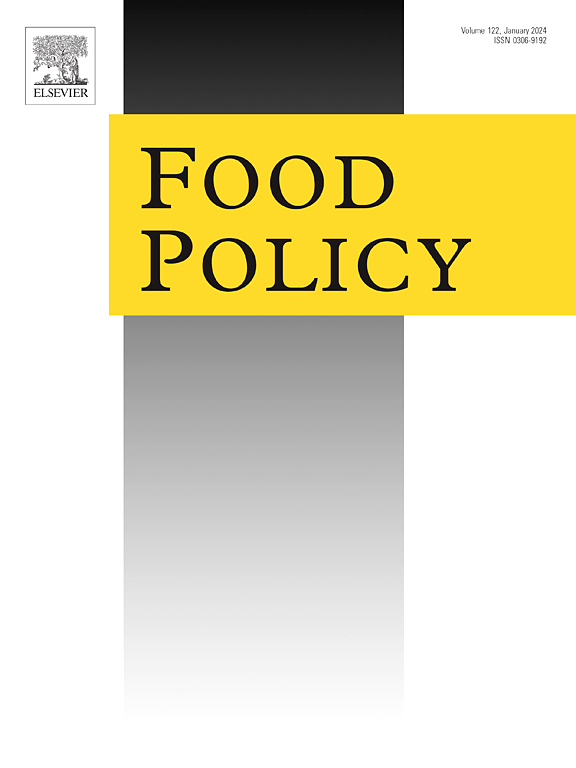Economic analysis of food self-sufficiency: modeling and application to the case of Israel
IF 6
1区 经济学
Q1 AGRICULTURAL ECONOMICS & POLICY
引用次数: 0
Abstract
We develop a partial equilibrium model to assess the agro-economic implications of food self-sufficiency policies aimed at reducing a developed country’s exposure to shocks in the world food markets. We apply the model to Israel, a country with a high dependence on food imports, rapid population growth, and a vegetative agricultural sector specializing in fresh fruit and vegetable production subject to land, labor, and water constraints. We simulate different levels of self-sufficiency, measured in relation to the vegetative food products recommended for consumption by the EAT–Lancet Commission (Willett et al. 2019). We find that, under Israel’s population and agricultural production resources in 2019 (our baseline year), the country can self-supply the EAT–Lancet vegetative diet, although not all nutritional intakes (particularly fat, energy, and protein) recommended by the Institute of Medicine of the National Academies (IMNA 2005) will be met. Increasing self-sufficiency requires shifting agricultural resources from the production of fresh vegetative products to more storable—and therefore more importable—products such as cereals, oils, fats, legumes, seeds, and nuts. Because such crops consume less water and labor than fruits and vegetables, land remains the main resource constraining self-sufficiency. We show that self-supply of the vegetative dietary needs of Israel’s forecasted population over the coming decades will necessitate expanding the country’s agricultural land resources and/or maintaining large stocks of storable-food products. Achieving high levels of self-sufficiency would inflict pronounced welfare loss, particularly to the farming sector. Consequently, subsidies to incentivize self-sufficiency would entail significant governmental expenditures.
粮食自给自足的经济分析:建模及其在以色列的应用
我们开发了一个部分均衡模型来评估粮食自给政策对农业经济的影响,该政策旨在减少发达国家受世界粮食市场冲击的影响。我们将该模型应用于以色列,这是一个高度依赖粮食进口、人口快速增长、受土地、劳动力和水资源限制,专门从事新鲜水果和蔬菜生产的植物农业部门的国家。我们模拟了不同程度的自给自足,根据EAT-Lancet委员会推荐的食用植物食品来衡量(Willett et al. 2019)。我们发现,根据以色列2019年(我们的基准年)的人口和农业生产资源,该国可以自给自足EAT-Lancet植物性饮食,尽管并非所有营养摄入量(特别是脂肪、能量和蛋白质)都能满足美国国家科学院医学研究所(IMNA 2005)的建议。提高自给自足需要将农业资源从生产新鲜的植物产品转移到更容易储存、因此更容易进口的产品,如谷物、油、脂肪、豆类、种子和坚果。由于这类作物比水果和蔬菜消耗更少的水和劳动力,土地仍然是制约自给自足的主要资源。我们表明,在未来几十年里,以色列预计人口的植物性饮食需求的自我供应将需要扩大该国的农业用地资源和/或维持大量储存食品的库存。实现高度的自给自足将造成明显的福利损失,特别是对农业部门。因此,鼓励自给自足的补贴将需要大量的政府支出。
本文章由计算机程序翻译,如有差异,请以英文原文为准。
求助全文
约1分钟内获得全文
求助全文
来源期刊

Food Policy
管理科学-农业经济与政策
CiteScore
11.40
自引率
4.60%
发文量
128
审稿时长
62 days
期刊介绍:
Food Policy is a multidisciplinary journal publishing original research and novel evidence on issues in the formulation, implementation, and evaluation of policies for the food sector in developing, transition, and advanced economies.
Our main focus is on the economic and social aspect of food policy, and we prioritize empirical studies informing international food policy debates. Provided that articles make a clear and explicit contribution to food policy debates of international interest, we consider papers from any of the social sciences. Papers from other disciplines (e.g., law) will be considered only if they provide a key policy contribution, and are written in a style which is accessible to a social science readership.
 求助内容:
求助内容: 应助结果提醒方式:
应助结果提醒方式:


